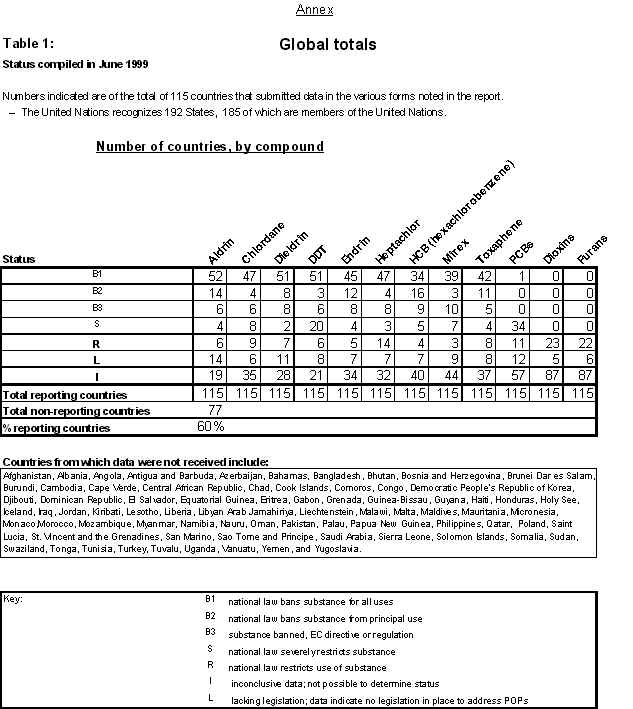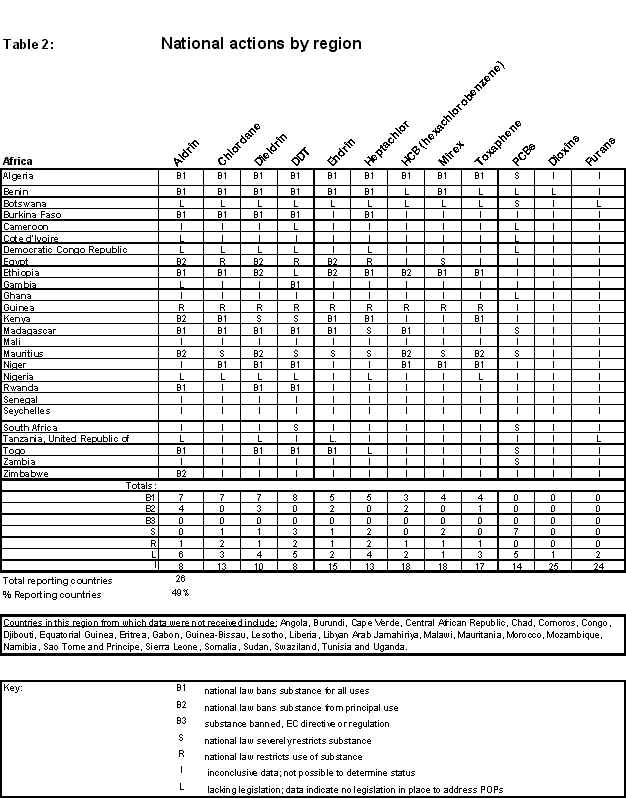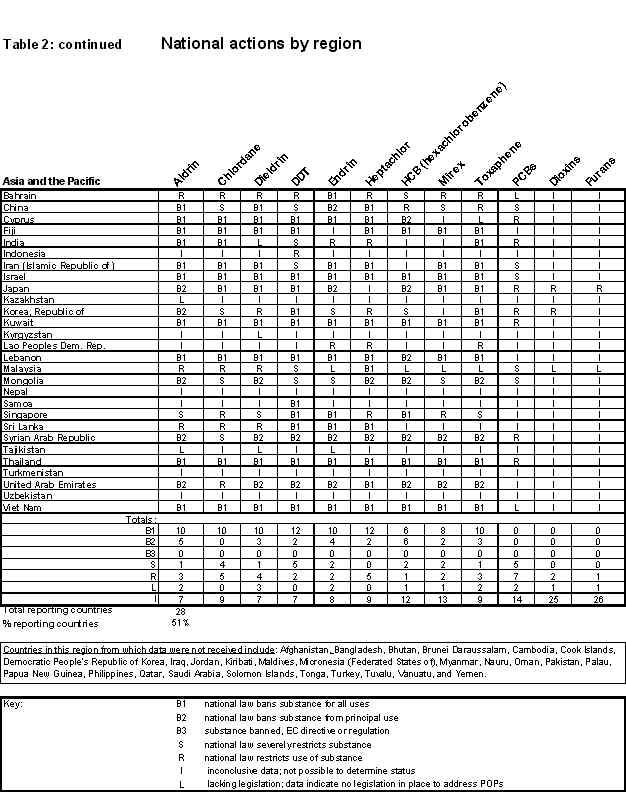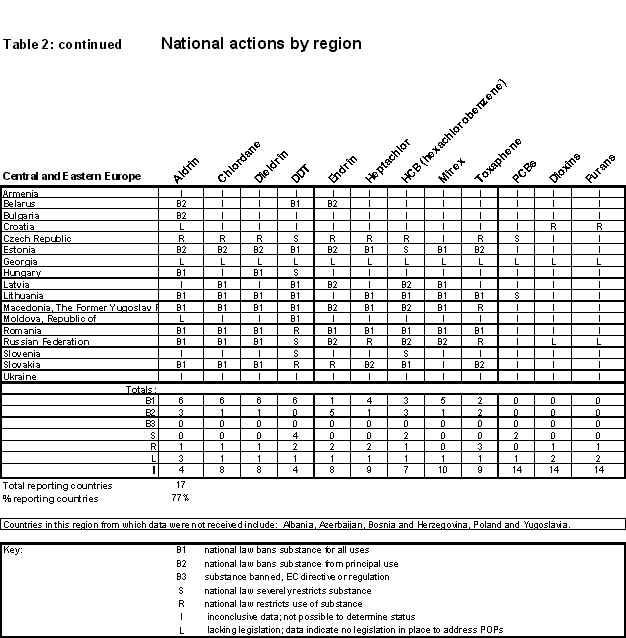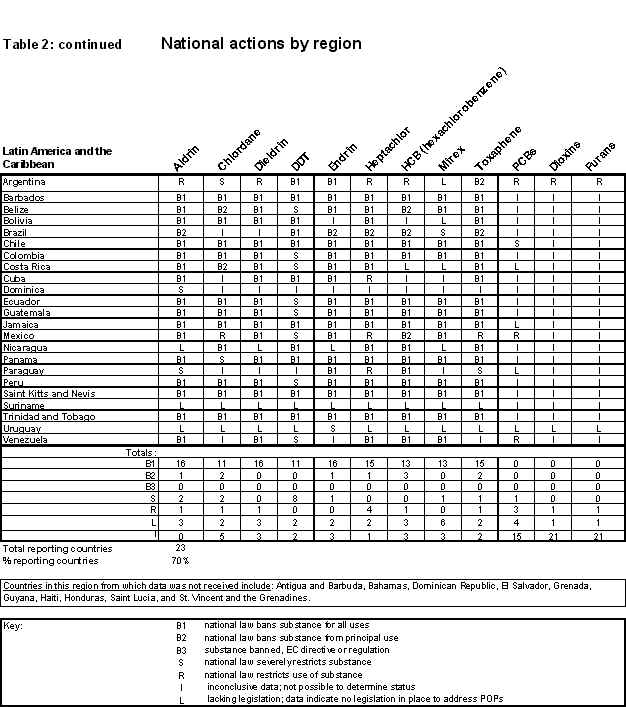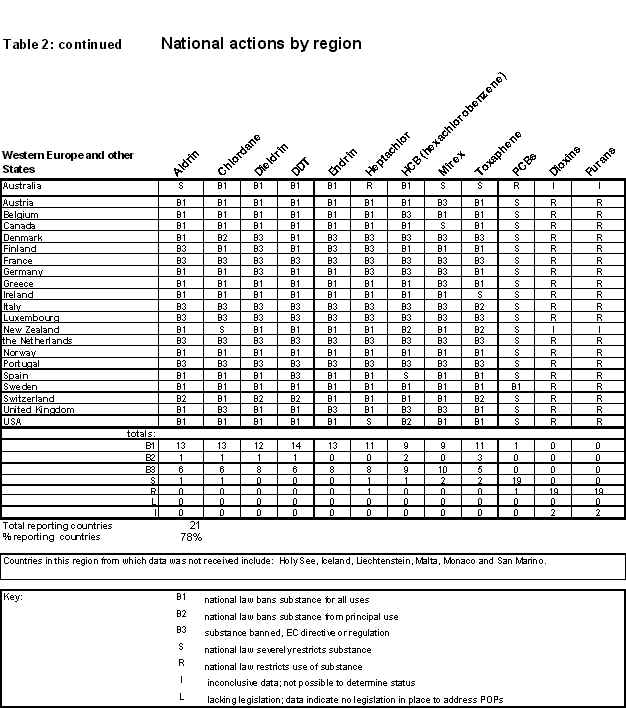

Environment
Programme
GENERAL
UNEP/POPS/INC.3/INF/2
14 June 1999
ORIGINAL: ENGLISH
| UNITED NATIONS |
EP |
|
United Nations Environment Programme
|
Distr. GENERAL UNEP/POPS/INC.3/INF/2 ORIGINAL: ENGLISH |
INTERGOVERNMENTAL NEGOTIATING COMMITTEE FOR AN
INTERNATIONAL LEGALLY BINDING INSTRUMENT FOR
IMPLEMENTING INTERNATIONAL ACTION ON
CERTAIN PERSISTENT ORGANIC POLLUTANTS
REPORT BY THE SECRETARIAT ON INTER-SESSIONAL WORK REQUESTED
BY THE COMMITTEE
Summary of existing national legislation
on persistent organic pollutants
Note by the secretariat
INTRODUCTION
1. At the second session of the Intergovernmental Negotiating Committee, the Implementation Aspects Group requested the secretariat to compile, inter alia, a summary of existing national legislation on persistent organic pollutants (POPs) for consideration at its next meeting (UNEP/POPS/INC.2/6, subparagraph 96 (c)).
2. In response to that request, the secretariat has prepared the present summary of existing national legislation and regulatory action on POPs. The summary is taken from a set of data described in paragraph 4 below. The full set of summary data, which includes information from 115 countries pertaining to the regulation of the production, use, import and export of the 12 specified POPs, will be available as an information document at the third session of the Intergovernmental Negotiating Committee. The tables contained in the annex to the present note focus on actions regulating use, except in the case of dioxins and furans, where the focus is on measures to restrict emissions.
3. The summary is limited to national legislative and regulatory actions and those of regional economic integration organizations whose legislative and regulatory actions are directly applicable to their member States.
I. INFORMATION SOURCES
4. Information for the present summary was collected from the following sources:
Regulatory actions and guidelines concerning POPs, UNEP Chemicals, June 1998, which is based on the UNEP Chemicals Legal File, the Food and Agriculture Organization of the United Nations (FAO) prior informed consent (PIC) procedure database, and POPs information questionnaires received from Governments by UNEP Chemicals prior to May 1998;
POPs information questionnaires submitted by Governments to UNEP Chemicals between May 1998 and May 1999; and
Proceedings of eight regional and subregional POPs awareness-raising workshops held between July 1997 and June 1998, convened jointly by UNEP and the Intergovernmental Forum on Chemical Safety (IFCS).
5. Information gathered from those sources has certain very significant limitations. First, the completeness and quality of data vary from source to source. The information provided through the PIC procedure may be the most reliable since it derives from formal submissions by countries. Data from the regional and subregional workshops, on the other hand, are based on reports given by government experts, who may not always indicate the source of their information. Second, information submitted may be incomplete, unclear, or otherwise inconclusive. Third, the nature of the action taken can be difficult to discern without further information. Fourth, absence of a regulatory control does not necessarily mean that the use of the chemical is allowed (as in the case of unregistered pesticides). Fifth, for some countries, the data used are seriously out of date and may overlook important actions which those countries have taken more recently on POPs.
6. For the above reasons, it is important to consider the present summary as a first attempt to analyse available information which needs further work and continuous updating. Governments are invited to provide additional information to correct or update the information used here. The summary will be revised regularly to reflect new information received.
II. SUMMARY INFORMATION
7. For the purposes of this paper only, legislation and regulatory actions are grouped into the following categories:
(B1) General bans. This includes prohibitions on all known current uses of a chemical. Also included in this category are pesticides that are not registered for such use in a country that requires this and that has no significant non-pesticide uses;
(B2) Limited bans. This includes bans on one or more major use category without specification as to whether other uses are banned. Thus, a pesticide POP could be banned in agriculture, but bans on other uses, such as for the control of head-lice are not mentioned;
(B3) Bans by the European Community. This includes cases where the European Community has taken action to ban a POP but data from one or more European Community member States are missing or otherwise out of date;
(S) Severe restrictions. This includes bans on all major uses except for certain specified uses, such as the use of DDT for disease vector control purposes;
(R) Other restrictions. This includes prohibitions on some uses and other requirements related to the use of a chemical;
(L) Lacks legislation. This includes cases where a country has indicated that it lacks legislation necessary to regulate the use of a chemical or chemicals;
(I) Inconclusive. It was not possible to determine the level of action taken based on the data provided.
It is important to note that, on the basis of data available, it is often difficult to distinguish between the various levels of legislative or regulatory action taken in countries.
8. Information is summarized in two tables, the first on global totals, the second on national actions by region. In brief, the data available indicate a significant number of countries have taken action (range: 59-80) to ban or severely restrict the use of each of the nine POP pesticides. The summary indicates that one country has banned all uses of polychlorinated biphenyls (PCBs) and 34 have severely restricted their use. Legal action on the unintentionally generated by-products, dioxins and furans, is much less common and involves restrictions to reduce emissions rather than use bans. Data gaps remain large with no data available from 77 countries for any of the POPs. In addition, data on specific POPs from countries for which at least some data are available are, in a number of cases, inconclusive or missing. Thus, what is available is a very rough picture of the status of national legislative and regulatory action to address POPs. More complete and up-to-date information is needed from countries to develop a more accurate summary of this status.
